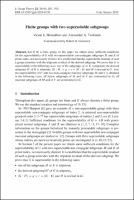Показать сокращенную информацию
Finite groups with two supersoluble subgroups
| dc.contributor.author | Monakhov, Victor | |
| dc.contributor.author | Trofimuk, Alexander | |
| dc.date.accessioned | 2020-11-10T15:24:30Z | |
| dc.date.available | 2020-11-10T15:24:30Z | |
| dc.date.issued | 2019 | |
| dc.identifier.citation | Monakhov, V.S. Finite groups with two supersoluble subgroups / V.S. Monakhov, A.A. Trofimuk // J. Group Theory. – 2019. – Vol. 22. – P. 297–312. | ru_RU |
| dc.identifier.uri | https://rep.brsu.by:443/handle/123456789/4631 | |
| dc.description.abstract | Let G be a finite group. In this paper we obtain some sufficient conditions for the supersolubility of G with two supersoluble non-conjugate subgroups H and K of prime index, not necessarily distinct. It is established that the supersoluble residual of such a group coincides with the nilpotent residual of the derived subgroup. We prove that G is supersoluble in the following cases: one of the subgroups H or K is nilpotent; the derived subgroup G0 of G is nilpotent; jG W Hj D q > r D jG W Kj and H is normal in G. Also the supersolubility of G with two non-conjugate maximal subgroupsM and V is obtained in the following cases: all Sylow subgroups of M and of V are seminormal in G; all maximal subgroups of M and of V are seminormal in G. | ru_RU |
| dc.language.iso | en | ru_RU |
| dc.publisher | de Gruyter | ru_RU |
| dc.title | Finite groups with two supersoluble subgroups | ru_RU |
| dc.type | Article | ru_RU |
